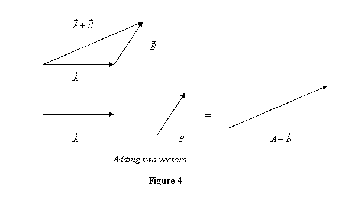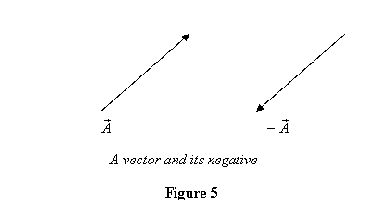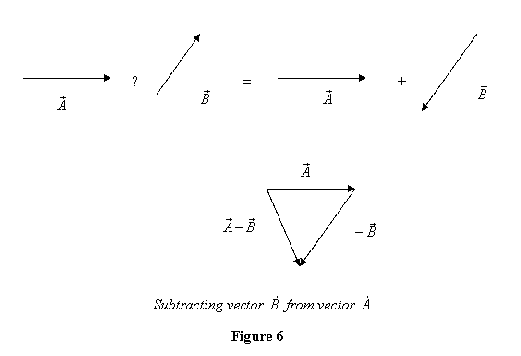Adding and subtracting two vectors (Graphical Method):
When we add two vectors ![]() and
and ![]() by graphical method to get
by graphical method to get ![]() , we take vector
, we take vector ![]() , put the tail of
, put the tail of ![]() on the head of
on the head of ![]() .Then we draw a vector from the tail of
.Then we draw a vector from the tail of ![]() to the head of
to the head of ![]() . That vector represents the resultant
. That vector represents the resultant ![]() (Figure 4). I leave it as an exercise for you to show that
(Figure 4). I leave it as an exercise for you to show that ![]() . In other words, show that vector addition is commutative.
. In other words, show that vector addition is commutative.
Let us try to understand that it is indeed meaningful to add two vectors like this. Imagine the following situations. Suppose when we hit a ball, we can give it velocity ![]() . Now imagine a ball is moving with velocity
. Now imagine a ball is moving with velocity ![]() and you hit it an additional velocity
and you hit it an additional velocity ![]() . From experience you know that the ball will now start moving in a direction different from that of
. From experience you know that the ball will now start moving in a direction different from that of ![]() . This final direction is the direction of
. This final direction is the direction of ![]() and the magnitude of velocity now is going to be given by the length of
and the magnitude of velocity now is going to be given by the length of ![]() .
.
Now if we add a vector ![]() to itself, it is clear from the graphical method that its magnitude is going to be 2 times the magnitude of
to itself, it is clear from the graphical method that its magnitude is going to be 2 times the magnitude of ![]() and the direction is going to remain the same as that of
and the direction is going to remain the same as that of ![]() . This is equivalent to multiplying the vector
. This is equivalent to multiplying the vector ![]() by 2. Similarly if 3 vectors are added we get the resultant
by 2. Similarly if 3 vectors are added we get the resultant ![]() . So we have now got the idea of multiplying a vector by a number n . If simply means: add the vector n times and this results in giving a vector in the same direction with a magnitude that n times larger.
. So we have now got the idea of multiplying a vector by a number n . If simply means: add the vector n times and this results in giving a vector in the same direction with a magnitude that n times larger.
You may now ask: can I multiply by a negative number? The answer is yes. Let us see what happens, for example, when I multiply a vector ![]() by -1. Recall from your school mathematics that multiplying by -1 changes the number to the other side of the number line. Thus the number -2 is two steps to the left of 0 whereas the number 2 is two steps to the right. It is exactly the same with vectors. If
by -1. Recall from your school mathematics that multiplying by -1 changes the number to the other side of the number line. Thus the number -2 is two steps to the left of 0 whereas the number 2 is two steps to the right. It is exactly the same with vectors. If ![]() represents a vector to the right,
represents a vector to the right, ![]() would represent a vector in the direction opposite i.e. to the left. It is now easy to understand what does the vector
would represent a vector in the direction opposite i.e. to the left. It is now easy to understand what does the vector ![]() represent? It is a vector of the same magnitude as that of
represent? It is a vector of the same magnitude as that of ![]() but in the direction opposite to it (Figure 5). Having defined
but in the direction opposite to it (Figure 5). Having defined ![]() , it is now easy to see what is the vector
, it is now easy to see what is the vector ![]() ? It is a vector of magnitude
? It is a vector of magnitude ![]() in the direction opposite to
in the direction opposite to ![]() .
.
Having defined ![]() , it is now straightforward to subtract one vector from the other. To subtract a vector
, it is now straightforward to subtract one vector from the other. To subtract a vector ![]() from
from ![]() , we simply add
, we simply add ![]() to
to ![]() that is
that is ![]() . Thus to subtract vector
. Thus to subtract vector ![]() from
from ![]() graphically, we add
graphically, we add ![]() and
and ![]() . This is shown in figure 6.
. This is shown in figure 6.
Again I leave it as an exercise for you to show that ![]() is not equal to
is not equal to ![]() but
but![]() = –
= – ![]() . We now solve a couple of examples.
. We now solve a couple of examples.


